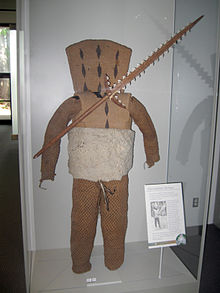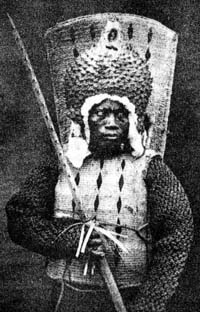Kiribati coconut fiber armor
| Kiribati coconut fiber armor | |
|---|---|

|
|
| Information | |
| Weapon type: | armor |
| Designations: | Coconut fiber armor |
| Use: | weapon |
| Region of origin / author: |
Kiribati |
| Distribution: | Kiribati, Tuvalu, Nauru |
| Lists on the subject | |

The Kiribati coconut fiber armor ( Gilbertese : Te tanga buaka ni ), ( Engl. Coconut fiber armor ) is a protection weapon from Kiribati in the form of a whole body armor. Similar armaments are also known from Tuvalu and Nauru .
description
The Gilbertese coconut fiber armor (today Kiribati) consists of the braided fibers of the coconut palm (Cocos nucifera). The fibers are woven and then put together to make a helmet, trousers and breastplate with sleeves.
The helmet is shell-shaped and has cheek protection. Optionally, the hedgehog helmet or other helmets were worn with this armor. The jacket is very tightly braided as breastplate, it has a long back shield that protrudes far above the head. This serves to protect the neck and back from attacks and also offers protection from hits from within your own ranks. In Kiribati it was customary for the women and members of the group or tribe who did not participate in hand-to-hand combat to stand a little further behind the line of warriors. They threw stones and coral chunks over the heads of the warriors at their opponents .
The jacket can be opened on both sides, allowing you to put it on. It is closed with a ribbon on the chest. The sleeves are more coarsely braided than the chest piece.
The pants are also roughly braided and cover the legs up to about the ankles. A kind of braces , which are also made of coconut fiber, are used to hold the pants in their position. Shoes were not worn, but the warriors probably still had a cloth undergarment underneath this armor.
Due to their rigidity, it was difficult to move around in the armor. Every warrior therefore had a helper who served as a weapon bearer. The armor is strong enough due to its processing and the material used to stop the projectiles of earlier muskets , as well as spears and blows with clubs, swords or other shark tooth weapons .
On the armor there are mostly diamond-shaped decorations made of dark-colored coconut fiber , but often made of women's hair cord . In addition, an armored belt and a breastplate made of ray skin were often worn.
As a weapon, the warriors of the Gilbert Islands used a kind of sword or club made of coconut wood, which consisted of three "blades" and is called taumangaria . Shark teeth attached to the edges of the weapon served as the cutting edge.
literature
- Adrienne Lois Kaeppler : The Pacific arts of Polynesia and Micronesia. Oxford University Press, 2008, ISBN 978-0-19-284238-1 , p. 133.
- George Cameron Stone : A Glossary of the Construction, Decoration and Use of Arms and Armor: in All Countries and in All Times. Courier Dover Publications, 1999, ISBN 978-0-486-40726-5 , pp. 64-65.
- David Stanley: South Pacific handbook. David Stanley, 1982, ISBN 978-0-9603322-3-6 , p. 426.
- Kiribati: Aspects of History. Institute of Pacific Sudies, Suva, Fidji, Tarawa 1979, ISBN 978-982-02-0051-7 .
- Gerd Koch : Material culture of the Gilbert Islands. Nonouti, Tabiteuea, Onotoa. Museum für Völkerkunde, Berlin 1965 ( Publications of the Museum für Völkerkunde, Berlin. Department: Südsee 3 = Publications of the Museum für Völkerkunde Berlin. NF 6, ISSN 0522-9766 ). (On the subject: Chapter: Weapons, pp. 193–197, with illustrations).
Web links
- Coconut fiber armor in the American Museum of Natural History in New York City, New York on Flickr
- Coconut fiber armor in the American Museum of Natural History in New York City, New York on Flickr (close-up)
Individual evidence
- ↑ Kiribati coconut fiber armor in the Pitt Rivers Museum , inventory no. 1941.2.74 , English, accessed December 25, 2011
